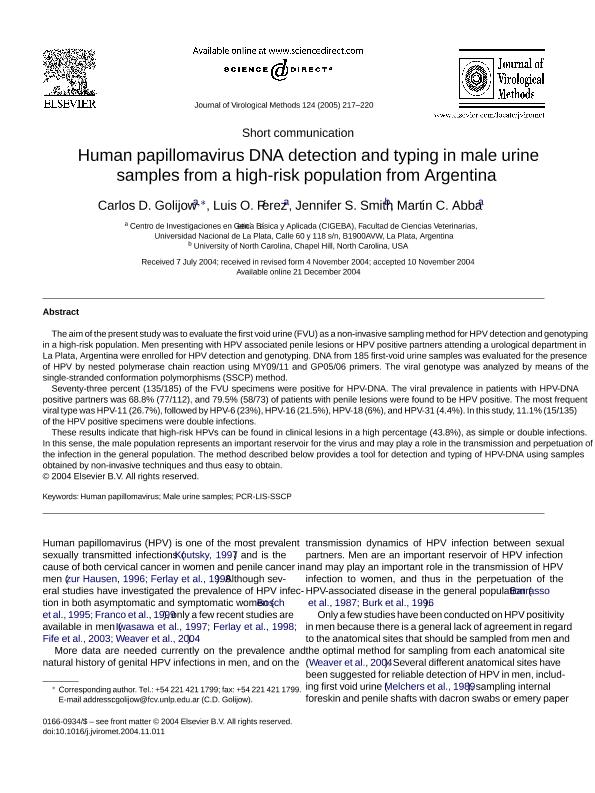Mostrar el registro sencillo del ítem
dc.contributor.author
Golijow, Carlos Daniel

dc.contributor.author
Perez, Luis Orlando

dc.contributor.author
Smith, Jennifer S.
dc.contributor.author
Abba, Martín Carlos

dc.date.available
2019-08-07T20:05:33Z
dc.date.issued
2005-03
dc.identifier.citation
Golijow, Carlos Daniel; Perez, Luis Orlando; Smith, Jennifer S.; Abba, Martín Carlos; Human papillomavirus DNA detection and typing in male urine samples from a high-risk population from Argentina; Elsevier Science; Journal of Virological Methods; 124; 1-2; 3-2005; 217-220
dc.identifier.issn
0166-0934
dc.identifier.uri
http://hdl.handle.net/11336/81155
dc.description.abstract
The aim of the present study was to evaluate the first void urine (FVU) as a non-invasive sampling method for HPV detection and genotyping in a high-risk population. Men presenting with HPV associated penile lesions or HPV positive partners attending a urological department in La Plata, Argentina were enrolled for HPV detection and genotyping. DNA from 185 first-void urine samples was evaluated for the presence of HPV by nested polymerase chain reaction using MY09/11 and GP05/06 primers. The viral genotype was analyzed by means of the single-stranded conformation polymorphisms (SSCP) method. Seventy-three percent (135/185) of the FVU specimens were positive for HPV-DNA. The viral prevalence in patients with HPV-DNA positive partners was 68.8% (77/112), and 79.5% (58/73) of patients with penile lesions were found to be HPV positive. The most frequent viral type was HPV-11 (26.7%), followed by HPV-6 (23%), HPV-16 (21.5%), HPV-18 (6%), and HPV-31 (4.4%). In this study, 11.1% (15/135) of the HPV positive specimens were double infections. These results indicate that high-risk HPVs can be found in clinical lesions in a high percentage (43.8%), as simple or double infections. In this sense, the male population represents an important reservoir for the virus and may play a role in the transmission and perpetuation of the infection in the general population. The method described below provides a tool for detection and typing of HPV-DNA using samples obtained by non-invasive techniques and thus easy to obtain.
dc.format
application/pdf
dc.language.iso
eng
dc.publisher
Elsevier Science

dc.rights
info:eu-repo/semantics/openAccess
dc.rights.uri
https://creativecommons.org/licenses/by-nc-sa/2.5/ar/
dc.subject
Human Papillomavirus
dc.subject
Male Urine Samples
dc.subject
Pcr-Lis-Sscp
dc.subject.classification
Bioquímica y Biología Molecular

dc.subject.classification
Ciencias Biológicas

dc.subject.classification
CIENCIAS NATURALES Y EXACTAS

dc.title
Human papillomavirus DNA detection and typing in male urine samples from a high-risk population from Argentina
dc.type
info:eu-repo/semantics/article
dc.type
info:ar-repo/semantics/artículo
dc.type
info:eu-repo/semantics/publishedVersion
dc.date.updated
2019-07-17T17:49:23Z
dc.journal.volume
124
dc.journal.number
1-2
dc.journal.pagination
217-220
dc.journal.pais
Países Bajos

dc.journal.ciudad
Amsterdam
dc.description.fil
Fil: Golijow, Carlos Daniel. Consejo Nacional de Investigaciones Científicas y Técnicas. Centro Científico Tecnológico CONICET- La Plata. Instituto de Genética Veterinaria "Ing. Fernando Noel Dulout". Universidad Nacional de La Plata. Facultad de Ciencias Veterinarias. Instituto de Genética Veterinaria; Argentina
dc.description.fil
Fil: Perez, Luis Orlando. Consejo Nacional de Investigaciones Científicas y Técnicas. Centro Científico Tecnológico CONICET- La Plata. Instituto de Genética Veterinaria "Ing. Fernando Noel Dulout". Universidad Nacional de La Plata. Facultad de Ciencias Veterinarias. Instituto de Genética Veterinaria; Argentina
dc.description.fil
Fil: Smith, Jennifer S.. University of North Carolina; Estados Unidos
dc.description.fil
Fil: Abba, Martín Carlos. Consejo Nacional de Investigaciones Científicas y Técnicas. Centro Científico Tecnológico CONICET- La Plata. Instituto de Genética Veterinaria "Ing. Fernando Noel Dulout". Universidad Nacional de La Plata. Facultad de Ciencias Veterinarias. Instituto de Genética Veterinaria; Argentina
dc.journal.title
Journal of Virological Methods

dc.relation.alternativeid
info:eu-repo/semantics/altIdentifier/doi/http://dx.doi.org/10.1016/j.jviromet.2004.11.011
dc.relation.alternativeid
info:eu-repo/semantics/altIdentifier/url/https://www.sciencedirect.com/science/article/pii/S0166093404003441
Archivos asociados
